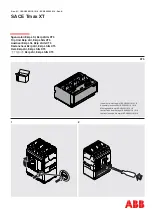
18
Instruction Book
IB182217EN October 2018 www.eaton.com
50 / 75 / 150 DHP [Cable or Hard Bus Application]
Ground and Test Device
4.7 INSTALLATION OF GROUNDING BUS BARS
otee:
N
Use hardware provided with the ground and test device installed
as shown. (Figure 5.1)
a. Determine the set of terminals to be grounded for test purposes.
Ground and Test bus bars may be used on the upper or lower
terminals of six terminal ground and test devices.
b. Using the key provided (Figure Set 3.3) with each G&T device,
unlock the appropriate door, exposing the terminals.
This feature is not applicable for single terminal ground and test
devices.
c. Using the included 1.5 inch long, ½-13 hex bolts with doubled flat
washers, attach one end of each grounding bus bar (Figure 3.2)
to the internal terminal corresponding to each phase (Figure 5.1).
Grounding bar can only be installed one way. Take care to align
the mounting bolts with the integral nut block behind the copper
terminal. Do not fully tighten the mounting hardware.
Figure 4.3. Attaching Grounding Bus Bars to Ground Bus
d. Attach the other end of the grounding bus bar to the horizontal
ground bar (Figure 5.1) with the included 1.5 inch long, ½-13 bolt
with double flat washers. Horizontal bus bar is between the upper
and lower terminal compartments. Weld nuts are located behind
this bus bar. Do not fully tighten the mounting hardware.
e. Returning to the internal terminals, fully tighten this hardware.
Torque to 50 ft lbs.
f. Finally tighten the hardware to secure grounding bus bar to
horizontal ground bus. Torque to 50 ft lbs.
g. When properly installed, the hard bus grounding parts are
configured to prevent closing the terminal access doors. Just as it
is impossible to close terminal doors on cable-type G&T devices,
the hard bus-style G&T device holds the access door open to
provide a visible reminder that the hard bus shorting bars are
installed.
4.8 DEVICE AMPERAGE CONVERSION PROCEDURE
The primary circuit terminals of the ground and test device consists
of cycloaliphatic bushings with silver plated copper conductor
‘knobs’. Primary disconnecting contacts are attached to the knobs;
these primary disconnects are configured to engage the circuit
breaker compartment primary disconnects. It is critical to confirm
that 1200 ampere primary disconnects are installed prior to insertion
in 1200 ampere circuit breaker compartments; likewise for tests in
2000 ampere circuit breaker compartments.
THIS CONVERSION
ALSO REQUIRES A CODE PLATE CHANGE PRIOR TO RACKING
THE G&T INTO ITS CIRCUIT BREAKER COMPARTMENT.
Follow
the procedure below to convert from one primary current design to
the other.
a. With the ground and test device located in an appropriate work
area, remove the existing primary disconnects installed on the
G&T using only the wrench provided (Figure 4.4) at the location
shown in Figure 4.5. Some wrenches can damage the primary
disconnect knobs; they should be avoided.
b. After removing the primary disconnect knobs, remove the primary
disconnects to be installed from the G&T storage bin and thread
them onto the bushings. The primary disconnects just removed
should be promptly stored in the storage bin to avoid damage to
them.
c. Hand tighten the primary disconnects onto the primary bushings.
Using the special wrench provided, complete tightening the
primary disconnect knobs until they are snug tight. Overtightening
these knobs is not necessary and may damage the knobs or
make them very difficult to remove at a future time.
d. THE GROUND AND TEST CODE PLATE MUST BE CHANGED AT
THIS TIME. The ground and test device will be blocked from full
insertion in the circuit breaker compartment until the code plate
position is changed. The code plate is a mandatory safety feature
that must not be removed and discarded.
e. The code plate position is changed by removing the two nuts and
bolts rotating the bracket 180 degrees and re-installing. Figure
4.1 shows the code plate positioned for insertion in 1200 ampere
circuit breaker compartments.
Figure 4.4. G&T Storage Compartment
Figure 4.5. Primary Disconnect Amperage Conversion
(2000A Adapter Bushing w/ 2000A Primary Disconnects Shown)































